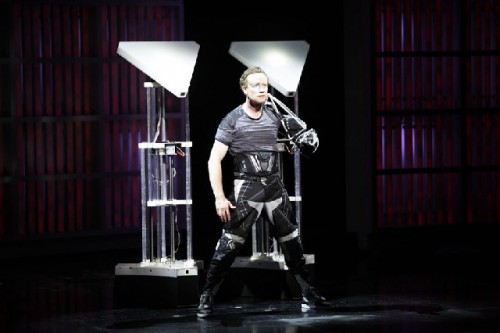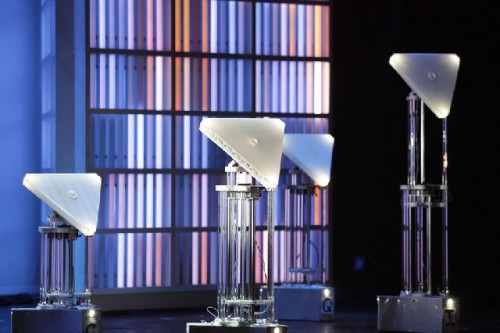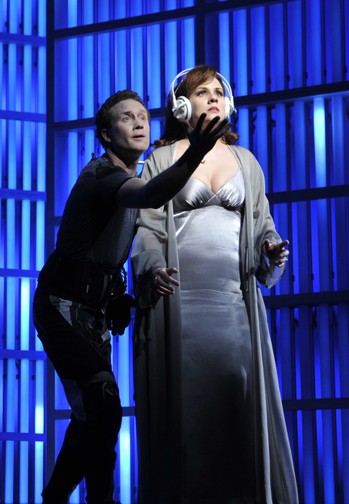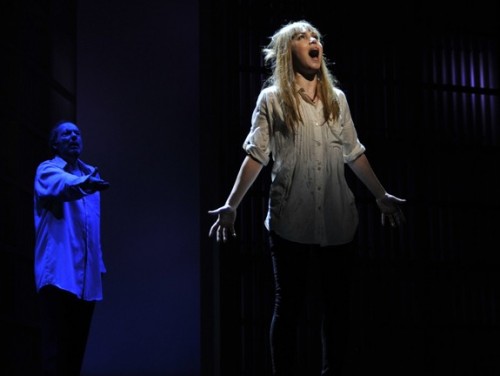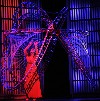Death and the Powers: The Robots’ Opera
Tod Machover Production at Cutler Majestic Theatre
By: David Bonetti - Mar 19, 2011
Death and the Powers: The Robots’ Opera
By Tod Machover
The Cutler Majestic Theatre
Friday, March 18.
Additional performances Sunday, March 20 at 3:30 p.m. and March 22 and 25 at 7:30 p.m.
Tickets: 617-824-8000 or www.aestages.org
What is opera? For most people, both fans and only occasional listeners, it is those romantic 19th century works that feature tragic love stories and soaring arias and ensembles that you can hum on the way home from the theater. “Lucia di Lammermoor” and “Tosca,” both of which were presented this season in Boston, the former by Teatro Lirico d’Europa; the latter by Boston Lyric Opera, are prime examples of the genre.
But in recent decades, the notion of what opera is has broadened to include both works composed in the 17th and 18th centuries and those composed over the past 100 years. At the moment, examples of the two chronological ends of opera are on the boards in Boston: Handel’s “Agrippina,” a production of Boston Lyric Opera, and Tod Machover’s “Death and the Powers: The Robots’ Opera,” a production of American Repertory Theater and MIT’s FAST Arts Festival. “Agrippina” was composed in 1709, toward the beginning of opera’s long history. It has hummable melodies and a couple of love stories that prefigure the standard 19th century repertory.
“Death and the Powers” was created during the past few years and is experiencing its American premiere this week in Boston. (It was premiered in Monaco and will be presented in Chicago in April.) It is a high-tech work on a science fiction theme, but it also features a couple of lyrical arias and a love story. So as much as things have changed, certain things remain constant. Opera is a human-interest story told through singing actors presented on a stage. What’s different is that the variety of opera performed today is broader and more diverse than ever before in history. Opera lovers are the beneficiaries.
MIT and the scientists and engineers associated with it have been responsible, at least partially, for many of the technological advances we often take for granted today. In her introductory essay to the catalogue of “Sensorium,” an exhibition that opened at MIT’s List Visual Arts Center in 2006, Jane Farver listed some of them: the telephone, optical networking, digital audio, the Global Positioning System, cell phones, fiber-optic communication, the computer, strobe photography, the instant camera, hi-fi speakers, the chemical synthesis of penicillin, the alcove hologram, the first computerized video game and a map of the human genome, among others. With his Opera of the Future Group at MIT’s Media Lab, Tod Machover is attempting to recreate opera for the future, one that still depends on music and singing, but that uses the latest technology to frame and present it. He’s been exploring new ideas for music theater for a couple of decades. I saw his legendary “VALIS” at MIT’s Black Box Theater in 1987. I found it riveting.
I found “Death and the Powers” less so. The visuals were fantastic; the ever-morphing and pulsating colors and images displayed on light boxes that were supposed to be three tall sets of library shelves, were mesmerizing. The technology used to realize the effects might already have found a home in a state-of-the-art disco or on Lady Gaga’s never-ending tour – I saw her in St. Louis, and believe me, the technology employed in her show could revolutionize opera in a totally delightful way if any company could afford it – but “Death and the Powers” looked pretty much opera-of-the-future at smaller scale.
An especially beautiful detail was a large construction called “the chandelier,” suggesting variously a gigantic Japanese basket, a Portuguese man of war, or a sculpture by the Russian constructivist Naum Gabo, that hung over the stage and descended, opening and closing, at one dramatic moment. The robots, which dominated much of the advance press, were cute, even endearing. They seemed to reassure us that we need not fear the future.
The technology used in the sound design, especially the elaborate computer-based recording of the sounds made by baritone James Maddalena when he was off-stage, left me cold, because, frankly, I am too technologically illiterate to really understand what was going on. It merely sounded as if he were singing off stage, an effect that is common enough in opera. My own lack of understanding probably limited my appreciation of the sound made by the chorus of robots and the “chandelier,” because I couldn’t really tell where the sound was coming from and why it was better or even different from conventionally produced sounds. So shoot me – I don’t twitter (or is it tweet?), either. This is an opera that geeks might best appreciate.
Now, speaking of shooting me, that brings us to the story.
Simon Powers is a “billionaire” who has invented a system, known as “The System,” that allows him to leave his decaying body behind while preserving his consciousness and ability to control his business and “write checks” from the beyond. Powers is one of those totally unsympathetic alpha males who want to continue to pull the strings after death. You know the type, they recently almost destroyed the world’s economy and took over the U.S. House of Representatives. You might want to see all of them dead, but Powers, alas, will not only never die, but he succeeds in bringing his wife, Evvy, and his protege, Nicholas, with him into his own private twilight zone. Only his daughter, Miranda, resists his call to stay on earth with all the other imperfect creatures – actually called “the miseries” - who don’t have her father’s resources.
Okay, science fiction is a hard sell for me, but I was able to suspend my disbelief to appreciate “VALIS,” which was adapted from a work by sci-fi master Philip K. Dick. “Death and the Powers,” alas, was written by Randy Weiner, husband of ART director Diane Paulus, and poet Robert Pinsky, the former poet laureate. The premise of the story is promising: man who wants to control the world after death of his body figures out how to do so. But the text is embarrassing: pretentious, overly literary and generally tone-deaf about language. One would expect better from the former poet laureate. The dichotomy that structures the story is between body and soul. Pinsky insists on calling it “meat” and “light.” Well, “light” is fine, but the endless repetition of “meat, meat, meat” almost made me laugh. Couldn’t someone on the large production team have spoken up?
Machover, who holds a position as professor in MIT’s music department, wrote a serviceable, often enjoyable score. His style is eclectic but generally tonal. There were hints of medieval chant, 20th century dissonance, musical comedy and the chugging rhythms of Philip Glass. It all held together well. He also wrote a couple of old-fashioned show-stopping pieces. Evvy’s aria to her husband swallowed up into “The System” while she is enveloped in the chandelier, is richly erotic. “Touch me, touch me, touch me,” she sings over and over as she writhes below. Earlier she and her daughter have a lovely duet about how they will recognize their husband/father once he gives up his body.
The cast was excellent. Baritone James Maddalena, fresh from his role at the Met as the title character in “Nixon in China,” sang Simon Powers as a Nixonian Everyman. Unfortunately, Pinsky fails to humanize him as Alice Goodman did the President that, at the end, everyone hated. Emily Albrink’s lush soprano did humanize Evvy. She was totally convincing as the type of woman who stands by her man no matter how unlikable he is. Sarah Heaton, as the one sympathetic character, sang with a lovely young soprano voice although a couple of high notes proved to be beyond her. Tenor Hal Cazelet as Nicholas was fine as were the minor characters Douglas Dodson, David Kravitz and Tom McNichols, who sang, respectively, The United Way, The United Nations and The Administration.
Director Diane Paulus kept the stage action clean and legible – there were no extraneous touches here. Choreographer Karole Armitage didn’t seem to have much to do, but at one moment, the grouping of the robots recalled the dancing mushrooms in Walt Disney’s “Fantasia,” and the dance of the Miseries was appropriately disruptive and terrifying.
I wish I could comment on orchestra director Gil Rose, but I really don’t know what he did to create the sound as opposed to the computers. Sorry! The general production design is credited to Alex McDowell. Bravo to him for the visuals, but there are another seven who are also credited for other aspects of design, and they all did their jobs superbly. It’s a shame that all the musical and visual talent was expended on such a problematic text.


